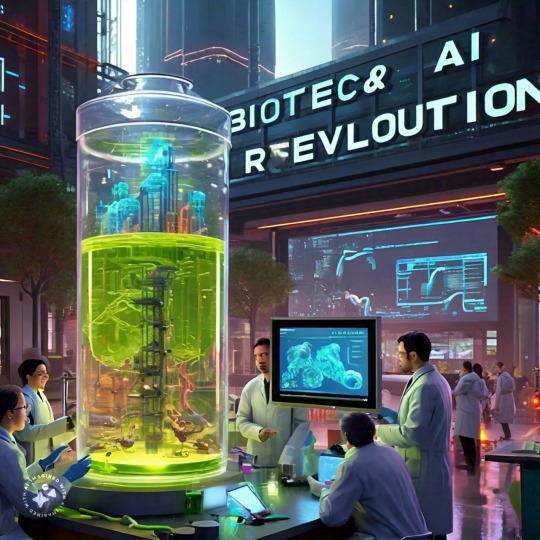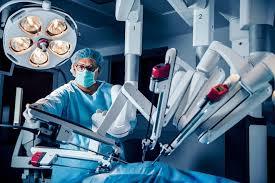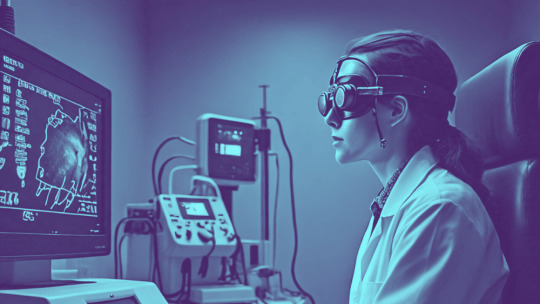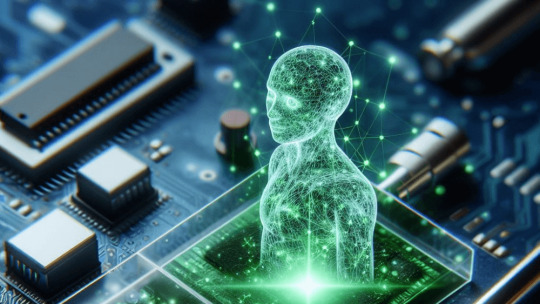#AI diagnostics
Text
The Impact of AI on Everyday Life: A New Normal
The impact of AI on everyday life has become a focal point for discussions among tech enthusiasts, policymakers, and the general public alike. This transformative force is reshaping the way we live, work, and interact with the world around us, making its influence felt across various domains of our daily existence.
Revolutionizing Workplaces
One of the most significant arenas where the impact…

View On WordPress
#adaptive learning#AI accessibility#AI adaptation#AI advancements#AI algorithms#AI applications#AI automation#AI benefits#AI capability#AI challenges#AI collaboration#AI convenience#AI data analysis#AI debate#AI decision-making#AI design#AI diagnostics#AI discussion#AI education#AI efficiency#AI engineering#AI enhancement#AI environment#AI ethics#AI experience#AI future#AI governance#AI healthcare#AI impact#AI implications
1 note
·
View note
Text
Mind and Machine: Exploring the Revolutionary Impact of AI on Psychology
Artificial Intelligence (AI) is transforming numerous sectors, including psychology, a field dedicated to understanding human behavior and mental processes. AI’s ability to process vast amounts of data at unprecedented speeds offers significant potential to enhance psychological research, diagnostics, and treatment methods. This convergence promises to unlock deeper insights into the human mind,…

View On WordPress
#AI Diagnostics#AI in Research#Artificial Intelligence#Clinical Psychology#Ethical AI#Future of Psychology#Machine Learning#Mental Health Technology#Psychological Innovation#Psychology
0 notes
Link
Tumors that affect the central nervous system are among the most fatal kinds of cancer, especially in pediatric cases. Surgical removal of the tumor is usually the prescribed course of action, made harder by the fact that the surgeons performing the procedure will not be able to determine the kind of tumor they’re dealing with beforehand, limiting their ability to come up with a plan in advance. A new tool utilizing neural networks seeks to improve the landscape of cancer diagnostics by providing a rapid and accurate mechanism to classify CNS tumors in an intraoperative setting.
Primary treatments for tumors of the nervous system usually involve the excision of the tumor through surgery, this is a difficult procedure to perform, requiring surgeons to make decisions regarding how much of it can be excised without posing a threat to the neural system and increasing the chances of comorbidity.
The determination of the kind of tumor is crucial to be able to identify the necessity and amount of resection that can be feasibly carried out. Certain tumors are presently viewed as being incurable, hence, the surgeon’s aim while operating on a patient must be to acquire tissue samples for proper diagnosis while preserving the patient’s quality of life as much as possible. However, it may be beneficial to attempt a complete resection as possible for other kinds of tumors, as it improves survival.
Continue Reading
65 notes
·
View notes
Link
#caption health#ai#artificial intelligence#diagnostics#ultrasound#home health#medtech#health tech#cardiology#heart disease#heart health
2 notes
·
View notes
Text
Paul Roscoe, Chief Executive Officer, CLEW Medical – Interview Series
New Post has been published on https://thedigitalinsider.com/paul-roscoe-chief-executive-officer-clew-medical-interview-series/
Paul Roscoe, Chief Executive Officer, CLEW Medical – Interview Series
Paul Roscoe is the Chief Executive Officer of CLEW Medical.
Prior to joining Clew, Mr Roscoe was CEO of Trinda Health, and was responsible for establishing the company as the industry leader in quality oriented clinical documentation solutions.
CLEW Medical offers hospitals, healthcare systems and intensive care units advanced clinical intelligence and patient diagnostics using AI-powered, FDA-cleared predictive analytics and proprietary critical care models.
Could you start by telling us a bit more about CLEW Medical’s AI-enabled platform and its unique capabilities in the MedTech industry?
CLEW’s founding was based on the premise that data analytics and AI can significantly improve patient outcomes and clinician experience in high-acuity care settings. The clinical surveillance platform we’ve built is the first to have FDA-cleared AI-driven prediction models for critical care. Our system obtains data by integrating with all clinical data sources within a hospital and builds a near real-time physiological profile of each patient to continuously monitor their status. It then uses this data to provide predictive insights to identify patients who will likely have an adverse event – such as respiratory failure – and alert clinicians to intervene up to eight hours before the anticipated event. The platform’s high degree of accuracy also reduces the excessive number of false alarms, enabling clinicians to practice at the top of their license and focus on patients most in need of immediate intervention.
What were the key factors that contributed to the FDA clearance of CLEW’s AI-driven predictive models?
CLEW has embraced AI since its inception. Our founders and developmental leaders recognized the significance of fostering trust with caregivers, the individuals responsible for utilizing our technology to care for their most vulnerable patients. It was imperative that our technology undergo the same level of scrutiny and diligence in design, development, testing, and validation as the devices already in use by our users. To encourage the adoption of an AI solution for critical care settings, our team understood the necessity of building models with meticulous product development and quality systems. As a result, our AI model development leverages robust MLOPS (machine learning operations) infrastructure to meet regulatory expectations, such as the PCCP (pre-authorized change control plan) guidance from the FDA. Our AI models are methodically designed, while undergoing all necessary experiments for medical device regulatory clearance.
The robustness of the models and our internal processes resulted in the FDA classifying our solution as a class II medical device in early 2021, which exemplified a landmark, first-of-its-kind achievement. FDA medical device clearance serves as a testament to the quality of our end-to-end development process, which includes clinical validation studies conducted in real patient populations.
The recent study published in CHEST® Journal highlighted the predictive accuracy of your AI models. Can you discuss the methodology and the specific findings of this study?
A CLEW-trained ML algorithm was deployed in 14 intensive care units (ICUs) across two major health systems to predict intubation and vasopressor initiation events – in other words, events that require life-saving intervention – among critically ill adult patients. Its performance was measured against existing bedside monitoring alarms and the predictive effectiveness of telemedicine system alerts.
The study, designed to evaluate the tool’s accuracy and utility of alerts in ICUs, found that CLEW’s models for predicting patient deterioration were five times more accurate than and produced 50 times fewer alarms than the leading telemedicine system. The findings also show that the ML model has superior accuracy compared to traditional monitoring systems and drastically reduces unnecessary interruptions to clinician workflows.
How do the AI predictions made by CLEW’s platform potentially transform care delivery in the ICU? Could you elaborate on how these predictions improve outcomes and reduce complications?
CLEW’s platform produces opportunities for early interventions in high-risk patients and supports capacity management by identifying low-risk individuals who may be ready for step-down or discharge. This, in turn, decreases mortality and readmission rates, reduces complications caused by patient deterioration, and minimizes patients’ length of stay.
For example, within the first 24 hours of deployment at a major health system, our technology predicted hemodynamic instability in an ICU patient, which triggered a provider evaluation. Upon evaluating the patient, the provider ordered a CT scan and detected an abdominal bleed. The patient was rushed to the operating room for emergency surgery, infused with fluids and blood, and their life was ultimately saved. 24 hours later the patient was in stable condition.
Your system was found to be five times more accurate than a leading telemedicine monitoring system. What makes CLEW’s technology more effective in predicting critical patient deteriorations?
In general, ML-generated notifications are less frequent, have higher levels of accuracy and lower rates of errors such as false positives, and create longer pre-event lead times than other telemedicine system alerts and bedside monitoring system alarms. CLEW’s alerts are more accurate and functional and provide time for the care team to adopt countermeasures to prevent predicted outcomes. The sophisticated intelligence that CLEW provides is made possible by its ability to mine patient data from a health system’s electronic medical record (EMR), combined with ML models that have been rigorously tested and validated through peer-reviewed research and FDA clearance.
The study also noted a significant reduction in false alarms. How does reducing alarm fatigue benefit ICU staff, and what has been the feedback from healthcare professionals using your system?
98% of bedside monitoring notifications are false positives, leading to alarm fatigue and exacerbating historically high levels of clinician burnout. CLEW addresses alarm fatigue by reducing the number of auditory interruptions, increasing the percentage of actionable notifications for necessary provider intervention, and creating an overall calmer ICU environment. In essence, the platform’s accuracy and ability to reduce unnecessary workload via advanced ML models significantly improves ICU burnout. As part of the implementation process, CLEW’s customer success teams focus on the importance of clinical change management to ensure the technology is appropriately incorporated into the overall clinical decision-making process. The feedback from clinicians has been extremely positive.
How does the early notification feature of CLEW’s platform work, and what kind of interventions has it facilitated in real-world ICU settings?
Based on the incoming stream of information from bedside monitoring and life-support devices, as well as from the Electronic Health Record (EHR), the CLEW AI models can make predictions about the risk of patient deterioration and death over the next eight hours. With these predictive assessments, experienced clinicians can evaluate patients more closely and determine if there are applicable countermeasures to prevent the predicted deteriorations, instead of responding to them on an emergency basis.
For example, the CLEW platform can notify clinicians that a patient is highly likely to enter respiratory failure, which typically leads to intubation and mechanical ventilation. Upon receiving the alert, caregivers can then identify the patient has an excess of fluid that could start backing up into the lungs, and initiate diuretic therapy to reduce the fluids, thus preventing an intubation later. Our model can also anticipate whether a post-surgical patient is likely to become hemodynamically unstable and require vasoactive medication support. Armed with this knowledge in the absence of obvious symptoms, a CT-scan determined the patient had internal bleeding and was taken back to surgery to repair it. Ultimately, this intervention resulted in the patient being stabilized.
CLEW’s AI-enabled predictions also support hospitals with capacity management needs. Some patients will no longer require critical care and can be transferred to lower-acuity care units, freeing up beds to manage more critically ill patients. This allows the health system to improve capacity management and create access for more patients. This also increases contribution margin for the health system.
What are the next steps for CLEW Medical in terms of further developing and expanding the use of your AI-driven models in different healthcare settings?
We have already expanded the CLEW platform outside of critical care settings to include step-down units and emergency departments, and we are currently in the process of expanding across the remaining acute care beds of hospitals, including post-anesthesia care units (PACU) and general medical/surgical & specialty beds. The eventual ubiquity of inexpensive wearable monitors providing frequent vital signs information, along with our PCCP clearance, enables CLEW to expand its AI surveillance capabilities more broadly throughout acute care hospitals.
Additionally, as CLEW predictions are complementary to many other HIT systems including the EHR, we are working on delivering our insights via integration into a health system’s existing toolkit. We have joined the Epic developers’ network and have demonstrated successful integration of advanced CLEW capabilities such as AI-driven predictions into the clinical user experience.
CLEW is also embarking on a novel, AI-driven approach to sepsis management, a devastating and sometimes deadly complication.
Where do you see the future of AI in improving ICU care over the next decade, and how does CLEW plan to be a part of this future?
Hospital patient populations are sicker than they used to be. With increasing age and lifestyle-related chronic illnesses alongside widespread caregiver shortages, the need for intelligent clinical surveillance continues to grow. Since many patients end up in ICUs because of missed opportunities to intervene earlier in the care process, CLEW is not only focused on using its AI to improve ICU care, but also on partnering with health system and industry innovators to improve all acute care. Our programmatic pipeline for AI development (MLOPS) will harness partner capabilities to grow FDA-cleared AI models beyond what CLEW develops on its own.
However, technology is only a part of solution. The use of AI in healthcare is not about replacing caregivers. In fact, AI can offer superior information to support their decision making to provide optimal clinical care, such as reducing noisy alerts that waste their time. CLEW is working with health systems and partners to learn from and educate caregivers on how AI tools can be effectively adopted and accepted into clinical practice. Research that validates the accuracy and efficacy of AI is required, so CLEW works with its customers to generate this proof with their own patient populations. This focused research effort supports implementation and adoption by bedside caregivers who would otherwise be skeptical.
To expedite new clinical implementations, we have the ability to update our platform to include newly discovered best practices within a month, something that typically takes years. Over the next decade, CLEW will be at the forefront of working with health systems to make effective clinical AI the informed and prescient partner of the human caregivers who may someday care for us or our loved ones.
Thank you for the great interview, readers who wish to learn more should visit CLEW Medical.
#Acuity#ai#AI in healthcare#ai model#AI models#ai tools#AI-powered#alerts#algorithm#amp#Analytics#Anesthesia#approach#bleeding#blood#Building#burnout#CEO#change#change management#CLEW Medical#data#data analytics#decision making#deployment#Design#developers#development#devices#diagnostics
0 notes
Text
youtube
Why is healthcare so expensive in the US? Dr. Webb details one of the biggest inefficiencies in our healthcare system that stops patients from receiving the healthcare they truly need.
Fun fact I learned from this video: Did you know AI robots are responsible for assessing and approving patient surgeries?
#radiology#medical#diagnostic imaging#healthcare#insurance#ai#orthopedics#surgeon#mri#ultrasound#surgery#ct scan#Youtube
0 notes
Text
How Biotech and AI are Revolutionizing Industries
How Biotech and AI are Revolutionizing Industries
Biotechnology (biotech) and Artificial Intelligence (AI) are two rapidly advancing fields that are transforming various industries. Biotech involves using living organisms or biological systems to develop new products and technologies, while AI refers to the development of intelligent machines that can think and learn like humans.
The Connection…

View On WordPress
#Agricultural Biotech#agriculture#ai#Artificial Intelligence#bioinformatics#Biotech#biotechnology#Diagnostics#Drug Discovery#Environment.#healthcare#Medical Imaging#personalized medicine#synthetic biology
0 notes
Text
Harnessing the Power of AI: Embracing Technology in Healthcare

In today's rapidly advancing healthcare landscape, the integration of cutting-edge technologies is revolutionizing patient care and clinical practices. Among these technologies, Embracing Technology such as Artificial Intelligence (AI) is reshaping the way healthcare is delivered and experienced. In this blog post, we'll explore how healthcare organizations are harnessing the power of AI and other innovative technologies, including AI-powered Diagnostics, Personalized Medicine, Robotic-Assisted Surgery, Predictive Analytics, and Virtual Assistants & Chatbots, to enhance patient outcomes and improve operational efficiency.
AI-powered Diagnostics are transforming the field of medical diagnostics by leveraging machine learning algorithms to analyze complex datasets and identify patterns indicative of various diseases and conditions. AI-driven diagnostic tools can analyze medical images, laboratory results, and patient data with unparalleled accuracy and efficiency, enabling earlier detection and more precise diagnosis of diseases such as cancer, cardiovascular disorders, and neurological conditions.
Personalized Medicine is revolutionizing patient care by tailoring treatment plans to individual patients' genetic makeup, lifestyle factors, and disease characteristics. AI algorithms analyze vast amounts of patient data to identify optimal treatment strategies, predict treatment responses, and minimize adverse effects. By personalizing treatment approaches, healthcare providers can optimize therapeutic outcomes and improve patient satisfaction.
Robotic-Assisted Surgery is enhancing surgical precision and patient outcomes by combining the expertise of surgeons with the precision and dexterity of robotic systems. AI-powered surgical robots assist surgeons in performing complex procedures with greater accuracy, reduced invasiveness, and shorter recovery times. From minimally invasive surgeries to delicate procedures such as neurosurgery and cardiac surgery, robotic-assisted surgery is transforming the surgical landscape and expanding treatment options for patients.

Predictive Analytics harnesses the power of AI and big data to forecast patient outcomes, identify high-risk populations, and optimize resource allocation. By analyzing vast amounts of patient data, including electronic health records, medical imaging studies, and genomic information, predictive analytics models can anticipate disease progression, predict hospital readmissions, and guide preventive interventions. Healthcare organizations use predictive analytics to improve clinical decision-making, optimize care delivery, and reduce healthcare costs.
Virtual Assistants & Chatbots are enhancing patient engagement and access to care by providing on-demand support, information, and assistance. AI-powered virtual assistants and chatbots interact with patients through natural language processing technologies, answering questions, scheduling appointments, and providing personalized health recommendations. By offering convenient and accessible support, virtual assistants and chatbots empower patients to take an active role in managing their health and well-being.
In conclusion, Embracing Technology such as AI is transforming healthcare delivery by enhancing diagnostic accuracy, enabling personalized treatment approaches, improving surgical precision, facilitating predictive analytics, and enhancing patient engagement. By leveraging the power of AI-driven technologies such as AI-powered Diagnostics, Personalized Medicine, Robotic-Assisted Surgery, Predictive Analytics, and Virtual Assistants & Chatbots, healthcare organizations can deliver more efficient, effective, and patient-centered care in the digital age.
#AI-powered Diagnostics#Personalized Medicine#Robotic-Assisted Surgery#Predictive Analytics#Virtual Assistants & Chatbots
0 notes
Text
AI in Diagnostics Market Growth, Overview with Detailed Analysis | (2023-2033)
AI in diagnostics refers to the use of digital technologies, such as software, algorithms, and electronic devices, in the process of diagnosing medical conditions and diseases. This involves the integration of advanced technologies, such as artificial intelligence, machine learning, and data analytics, to enhance the accuracy and efficiency of diagnostic procedures in healthcare. Digital diagnostics encompass a range of applications, including digital imaging, in vitro diagnostics, point-of-care testing, telemedicine, wearable devices, and health information technology, all aimed at improving the precision and accessibility of medical diagnoses.
The global digital diagnostics market is projected to reach $8,319.2 million by 2033 from $1,431.7 million in 2023, growing at a CAGR of 19.24% during the forecast period 2023-2033
AI in Diagnostics Overview
AI has made significant strides in the field of diagnostics, revolutionizing the way diseases are detected and treated. In healthcare, AI-powered diagnostics leverage machine learning algorithms and deep learning techniques to analyze medical data such as images, genetic information, and patient records
Visit our Digital Diagnostics report click here !
Digital Diagnostics Market Dynamics
Market Drivers
Growing burden of chronic disease globally
The burden of chronic diseases refers to the significant impact and challenges posed by long-term medical conditions on individuals, healthcare systems, and society. Chronic diseases often persist over an extended period and may require ongoing medical attention and management. These diseases include cardiovascular diseases, diabetes, cancer, and respiratory illnesses.
Market Restraints
Challenges Regarding Biased Data Leading to Miscalculations in Data-Driven Diagnostic Software
The utilization of data-driven diagnostic software presents a promising frontier in modern healthcare. However, inherent challenges related to biasness or miscalculated data errors within these systems create significant hurdles. This arises as a restraining factor in the digital diagnostics market.
Market Opportunities
Digital diagnostics solutions in emerging economies
Low-economic countries, such as India, Brazil, and South Africa, present an increasing opportunity for digital diagnostics. They face a rising burden of chronic diseases due to increasing populations with a decreasing count of healthcare workers.
Download the sample page! Click Here
Market Segmentation
Based on application
Based on End Users
Based on Product
Based on Region
Key Players are as follows
• GE Healthcare
• Siemens Healthineers
• Medtronic plc
• Nano-X Imaging Ltd.
• Koninklijke Philips NV.
• Digital Diagnostics Inc.
• Riverain Technologies
Visit our Digital Health vertical page and have a look and better understanding for the same! Click here
Key Questions answers for Digital Diagnostics Market
Q What is Digital Diagnostics ?
Digital diagnostics refers to the application of digital technologies, including software, algorithms, and electronic devices, in the process of diagnosing medical conditions and diseases. This field involves the integration of advanced technologies such as artificial intelligence, machine learning, and data analytics to enhance the accuracy and efficiency of diagnostic procedures in healthcare. Digital diagnostics encompass a variety of applications, including but not limited to digital imaging, in vitro diagnostics, point-of-care testing, telemedicine, wearable devices, and health information technology. The overarching goal is to leverage digital tools to improve the precision, accessibility, and overall effectiveness of medical diagnoses.
Q What kind of new strategies are being adopted by the existing market players to strengthen the market position in the Industry ?
The global digital diagnostics market is currently witnessing several developments, primarily aimed at bringing new products and entering into collaborations and partnerships. Major manufacturers of products are actively undertaking significant business strategies to translate success in research and development into the commercial clinical setting. Many players are also looking forward to collaborations with hospitals and clinical laboratories.
Conclusion
In conclusion, the AI in diagnostics market holds tremendous promise for revolutionizing healthcare delivery. With advancements in machine learning, deep learning, and data analytics, AI-powered diagnostic tools offer unparalleled speed, accuracy, and efficiency in disease detection and prognosis. T
0 notes
Text
Unleashing the AI Revolution: How Artificial Intelligence is Transforming Our World
Discover the Next Frontier: Unlocking the Power of AI to Revolutionize Everyday Life
Hey there, fellow explorers! Buckle up because we’re about to embark on a wild ride through the fantastical world of artificial intelligence (AI). Picture this: a world where machines are more than just gadgets – they’re our partners in crime, revolutionizing everything from how we stay healthy to how we get…

View On WordPress
#AlgorithmicTrading#ArtificialIntelligence#Diagnostics#DigitalContent#DigitalTransformation#Finance#FraudPrevention#FutureTrends#KeywordOptimization#LSI#OnlineEngagement#Personalization#PersonalizedMedicine#SelfDrivingVehicles#SEO#SmartCity#SocietyImplications#Transportation#VirtualReality#ai#entertainment#healthcare#innovation#technology
1 note
·
View note
Text
According to Markets and Data Research report, “Global AI in Medical Diagnostics Market Assessment, By Region, Opportunities and Forecast, 2017-2031F”, the Global AI in Medical Diagnostics Market was valued at USD 1,642.02 million in 2023 and is expected to register CAGR of 26.40% during the forecast period.
0 notes
Text
The Big Sleep Mode
Philip Marlowe competes with some adaptive diagnostic software to figure out why a printer appears to be dead, and what happened to its print queue.
#bad idea#movie pitch#pitch and moan#the big sleep#philip marlowe#raymond chandler#mystery#thriller#printer#computer printer#print queue#printer queue#sleep mode#ai#artificial intelligence#diagnostic software
0 notes
Text
The advancement of electroretinography could be propelled forward with the introduction of a soft multi-electrode system

- By InnoNurse Staff -
This system, integrated into commercial disposable contact lenses, enhances the convenience of measuring electrical potentials on the retina, providing crucial diagnostic information for early detection of eye diseases like glaucoma and retinitis pigmentosa.
Read more at Waseda University
///
Other recent news and insights
Google DeepMind reveals the latest iteration of its AI model for drug discovery (Reuters)
#electroretinography#ophthalmology#diagnostics#medtech#health tech#ai#biotech#drug discovery#pharma#google#big tech#deepmind
0 notes
Text
Key role of AI accelerators in economic growth & social development
New Post has been published on https://thedigitalinsider.com/key-role-of-ai-accelerators-in-economic-growth-social-development/
Key role of AI accelerators in economic growth & social development

In today’s rapidly evolving digital landscape, artificial intelligence (AI) stands as a transformative force with the potential to revolutionize industries, spur innovation, and drive economic growth.
However, unlocking the full potential of AI requires overcoming significant computational challenges. This is where AI accelerators come into play. AI accelerators, specialized hardware designed to optimize AI workloads, play a crucial role in accelerating AI adoption, powering economic growth, and fostering social development.
Acceleration of AI adoption
AI accelerators serve as catalysts for the widespread adoption of AI technologies across various sectors. By enhancing the speed and efficiency of AI computations, these specialized hardware solutions enable organizations to harness the power of AI for a wide range of applications, from autonomous vehicles and healthcare diagnostics to finance and cybersecurity.
Furthermore, AI accelerators facilitate the deployment of AI models at scale, making it feasible for businesses of all sizes to integrate AI into their operations.

Driving economic growth
The widespread adoption of AI, fueled by AI accelerators, has the potential to drive significant economic growth.
By automating repetitive tasks, optimizing processes, and enabling data-driven decision-making, AI technologies enhance productivity and efficiency across industries, leading to increased output and competitiveness. Moreover, AI-powered innovations create new business opportunities, drive entrepreneurship, and stimulate job creation.
As businesses leverage AI to improve products and services, enhance customer experiences, and unlock new revenue streams, they contribute to economic expansion and prosperity.
Fostering social development
Beyond economic benefits, AI accelerators play a vital role in fostering social development and addressing pressing societal challenges. AI-driven solutions have the potential to revolutionize healthcare delivery, improving diagnostics, personalized treatment plans, and patient outcomes.
In education, AI-powered tools can enhance learning experiences, personalize instruction, and bridge gaps in access to quality education. Furthermore, AI technologies enable advancements in areas such as environmental monitoring, disaster response, and public safety, contributing to the well-being and resilience of communities worldwide.
Challenges and opportunities
While AI accelerators hold immense promise, their widespread adoption faces challenges such as high costs, technical complexity, and ethical considerations.
Addressing these challenges requires collaboration between governments, industry stakeholders, and the research community to develop affordable, accessible, and ethical AI solutions.
Moreover, investments in AI education and workforce development are essential to ensure that societies can fully harness the benefits of AI technology while mitigating potential risks.
Conclusion
In conclusion, AI accelerators play a pivotal role in accelerating AI adoption, driving economic growth, and fostering social development.
By enhancing the speed, efficiency, and scalability of AI computations, these specialized hardware solutions empower organizations to unlock the full potential of AI across various sectors.
As we navigate the digital age, embracing AI accelerators presents an unprecedented opportunity to harness the power of AI for the benefit of economies and societies worldwide, ushering in a new era of innovation, prosperity, and human progress.
Help shape the generative AI industry by sharing your expertise:
Generative Artificial Intelligence Report 2024
We’re diving deep into the world of generative artificial intelligence with our new report: Generative AI 2024, which will explore how and why companies are (or aren’t) using this technology.


Like what you see? Then check out tonnes more.
From exclusive content by industry experts and an ever-increasing bank of real world use cases, to 80+
deep-dive summit presentations, our membership plans are packed with awesome AI resources.
Subscribe now
#2024#accelerators#ai#AI adoption#AI Infrastructure#AI models#AI-powered#applications#artificial#Artificial Intelligence#autonomous vehicles#bridge#Business#catalysts#Collaboration#Community#Companies#complexity#content#cybersecurity#data#data-driven#deployment#development#diagnostics#Disaster response#diving#economic#education#efficiency
0 notes
Text
Proof of concept: AI model successfully identifies 90% of cases of lymphatic cancer

- By Nuadox Crew -
Researchers at Chalmers University of Technology in Sweden have made significant strides in the field of medical image analysis using artificial intelligence, particularly in the context of detecting lymph node cancer, or lymphoma.
Led by Associate Professor Ida Häggström, they've developed a sophisticated computer model named Lars (Lymphoma Artificial Reader System) that employs deep learning techniques to examine positron emission tomography (PET) images. This model has demonstrated an impressive accuracy rate of 90% in identifying signs of lymphoma, marking a substantial advancement in AI-assisted diagnosis.
Their groundbreaking study, published in The Lancet Digital Health, represents one of the largest endeavors in this domain, incorporating over 17,000 images sourced from more than 5,000 lymphoma patients. Through meticulous supervised training, where the AI system is exposed to labeled images and corresponding diagnoses, Lars has been trained to discern intricate patterns and features indicative of lymph node cancer. This process allows the model to continuously refine its diagnostic capabilities, gradually improving its accuracy over time.
The potential implications of this research extend far beyond lymphoma diagnosis alone. AI-assisted image analysis holds promise for various medical conditions, ranging from cardiovascular disease to osteoporosis.
By leveraging AI technology, radiologists can potentially streamline their workflow, receive second opinions, and prioritize patient treatment more efficiently. Moreover, this approach enhances accessibility to specialized expertise and expedites image review processes, irrespective of the patient's location or the hospital they are affiliated with.
Despite these promising developments, there are notable challenges on the horizon. Validating the efficacy and reliability of AI-driven diagnostic systems remains a crucial step before widespread clinical implementation can occur. Häggström emphasizes the necessity for extensive clinical testing to ensure the robustness and accuracy of their computer model. While the research team has made their code available for further collaboration and refinement, rigorous validation procedures are imperative to confirm the efficacy of AI-based diagnostic tools in real-world healthcare settings.
The potential implications of this research extend far beyond lymphoma diagnosis alone. AI-assisted image analysis holds promise for various medical conditions, ranging from cardiovascular disease to osteoporosis.
--
Source: Chalmers University of Technology
Full study: Ida Häggström et al, Deep learning for [18F]fluorodeoxyglucose-PET-CT classification in patients with lymphoma: a dual-centre retrospective analysis, The Lancet Digital Health (2023). DOI: 10.1016/S2589-7500(23)00203-0
Read Also
AI can help diagnose leukemia
#cancer#oncology#health#medicine#ai#imaging#lymphoma#medtech#health tech#tomography#diagnostics#radiology
1 note
·
View note
Text
Artificial Intelligence (AI) In Diagnostics Market Forecast 2030 by Manufacturing Technology, Key Manufacturers, Industry Trends

The global Artificial Intelligence (AI) in Diagnostics market size was valued at USD 1,172.46 million in 2022 and is anticipated to reach USD 5,123.16 million by 2030, exhibiting a remarkable CAGR of 23.45% during the forecast period from 2023 to 2030. These insights are drawn from an exhaustive report titled "Artificial Intelligence in Diagnostics Market Size" released by SNS Insider.
The integration of artificial intelligence in diagnostic processes has revolutionized the healthcare industry by enhancing the accuracy, efficiency, and speed of diagnoses. AI-powered diagnostic solutions leverage advanced algorithms, machine learning, natural language processing (NLP), context-aware computing, and computer vision technologies to analyze medical data and assist healthcare professionals in making more informed decisions.
Get Free PDF Sample Copy of Report @ https://www.snsinsider.com/sample-request/1849
The report segments the Artificial Intelligence in Diagnostics market based on component, technology, diagnosis type, and geographic scope:
Component: Hardware, Software, Services.
Technology: Machine Learning, NLP, Context-Aware Computing, Computer Vision.
Diagnosis Type: Radiology, Oncology, Neurology & Cardiology, Chest & Lungs, Pathology.
Geographic Scope: Regional and Global Markets.
Among these segments, the machine learning technology segment is expected to witness substantial growth during the forecast period, owing to its ability to analyze large datasets and identify patterns and anomalies with high accuracy. Additionally, the radiology diagnosis type segment is anticipated to dominate the market due to the increasing adoption of AI-powered imaging solutions for early disease detection and treatment planning.
Geographically, North America holds a significant share in the Artificial Intelligence in Diagnostics market, attributed to the presence of key market players, technological advancements in healthcare infrastructure, and favorable government initiatives supporting AI research and development. However, the Asia Pacific region is projected to witness rapid growth opportunities during the forecast period, driven by the increasing healthcare expenditure, rising prevalence of chronic diseases, and growing demand for advanced diagnostic solutions.
Key players operating in the Artificial Intelligence in Diagnostics market include HeartFlow, Inc., Therapixel SA, Nano-X Imaging Ltd., Prognos Health Inc., Butterfly Network, Inc., Aidence B.V., Siemens AG, GE Healthcare, Digital Diagnostics Inc., IBM. These companies are focusing on strategic collaborations, partnerships, and product innovations to gain a competitive edge in the market.
In conclusion, the global Artificial Intelligence in Diagnostics market is poised for substantial growth over the forecast period, driven by the increasing adoption of AI-powered diagnostic solutions, technological advancements in healthcare, and growing demand for accurate and efficient diagnostic tools.
#Artificial Intelligence (AI) In Diagnostics Market#Global Artificial Intelligence (AI) In Diagnostics Market#Artificial Intelligence (AI) In Diagnostics Market Size#Artificial Intelligence (AI) In Diagnostics Market Share#Artificial Intelligence (AI) In Diagnostics Market Trends#Artificial Intelligence (AI) In Diagnostics Market Growth#Artificial Intelligence (AI) In Diagnostics Market Demand#Artificial Intelligence (AI) In Diagnostics Market Segmentation#Artificial Intelligence (AI) In Diagnostics Market Analysis#Artificial Intelligence (AI) In Diagnostics Industry Analysis
0 notes